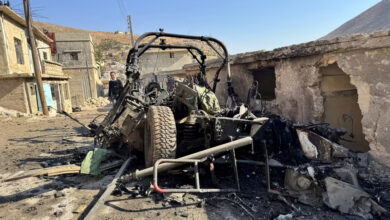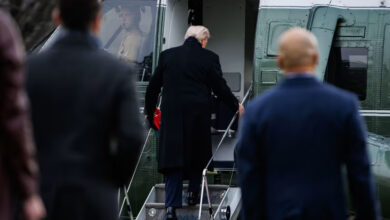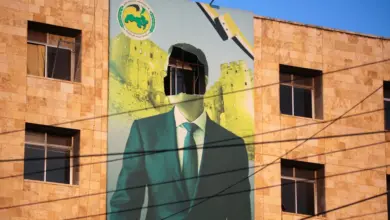
When Syria’s civil war came to the industrial city of Aleppo in 2012, two textile makers had to choose whether to stay or move their businesses away.
Nine months after fighting in Aleppo ended, the struggle of the one who stayed in the city to reopen his factory shows why the other will not return yet from the security of neighboring Jordan.
Restoring the Aleppo industries that have for decades underpinned Syria’s economy is vital if President Bashar al-Assad is to turn battlefield success into a fuller return of state power.
Moustafa Kawai, who remained in Aleppo, moved his cotton-weaving machines to a temporary site but now has workers clearing his battered factory of debris to reopen it.
“Our biggest problem is electricity. There are also very few workers because everyone’s in the army. Sanctions affect the work. Customers can’t come here. Transferring money is difficult. It’s hard to buy spare parts,” he said.
Mahmoud Akkad, a carpet manufacturer who like many Aleppo industrialists left Syria during the war, faces no such problems in Jordan where he has rebuilt his plant and kept up exports to old customers around the world.
“What do I benefit if I want to set up a factory and there is no safety,” he said, explaining the benefits of moving to an industrial zone in a country unaffected by Middle East turmoil.
The International Monetary Fund estimated last year that Syria’s economy had shrunk by 57 percent during the conflict and its manufacturing sector by 77 percent.
The war has since gone better for Assad as his army and its allies pushed rebels from Aleppo and other enclaves near important cities, and Islamic State from energy fields.
Growing confidence is evident in a new banknote bearing Assad’s face for the first time and in Damascus holding its once-annual trade fair after a long hiatus.
But the war still dominates Syria’s economy, even where the fighting has stopped. Most Aleppo factories were destroyed, badly damaged or looted.
Their workers fled as refugees or became combatants. Despite a new power line to the city, there is little electricity, leaving people reliant on expensive diesel generators. Water must be pumped electrically.
Fighting continues outside Aleppo. The army and allied militias who control the city operate checkpoints that some Syrians say demand bribes to let goods or workers pass, a charge the military denies. Travel outside the city means using narrow roads to bypass rebel territory and more checkpoints.
Western sanctions make foreign trade much harder, hindering the purchase of new equipment and payments for commercial deals. Although the government urges industry to return to areas where it has regained control, some businessmen say it is not doing enough to bring them back.
INCENTIVES
Fares Shehabi, the head of Aleppo’s chamber of industry, said that since the fighting ended, the number of factories and workshops had risen sharply.
Before the war there were 65,000, he said. When the rebels left in December there were 4,000. There are now 6,000, he said, attributing the rise to returning industrialists who are restarting their businesses.
But Shehabi, a supporter of Assad who has been sanctioned by the European Union for backing the government, is also critical of its reconstruction policy.
“There are some incentives but not enough,” he said during an interview, citing tax deductions and reduced customs tariffs for industrial imports for all Syrian customers as things the government has done.
There were no specific incentives offered for Aleppo. “They should treat us like a devastated area… we don’t have the level of administration that is needed to really save this industry, to make it run again,” he added.
In Jordan, Akkad said the Syrian government had encouraged him to return and he said he hopes to do so eventually. “It all depends on the circumstances improving,” he said.
He has built one factory that produces most of the same range of rugs and carpets he once made in Aleppo and is also investing in a new $5 million plant to make yarn.
Some of his most skilled weavers followed him to Jordan and few others remain in Aleppo. “Only five percent of my workforce have remained… Most headed to Germany, to Turkey,” he said.
INSECURITY
In 2010, Aleppo had about a third of Syria’s industrial companies and industry workers, Central Bureau of Statistics figures show. There were about a million people employed in its factories, Shehabi said.
During the decade before the war Assad’s economic reforms helped Aleppo’s businesses to grow more quickly.
Akkad was among the first to leave the small inner city workshops and move his operations into Sheikh Najjar, north of Aleppo, the biggest industrial zone in the city.
His family owned three factories there and was one of the biggest exporters of Syrian textiles.
Sheikh Najjar became a battlefield in 2013, occupied by successive forces whose warfare caused massive damage and who stripped plants of equipment. Akkad risked losing business relationships built over 50 years.
“Today you have customers all over the world. This is very costly to get a new network of customers. It’s more expensive than the plant itself,” he said.
He considered starting again in Turkey, Lebanon, or Egypt. Some city industrialists have moved to each of the three countries and others went elsewhere in Syria, but Akkad chose Jordan, untouched by the 2011 Arab uprisings.
His business is now located in a well-policed industrial zone there, the machine guns of Jordan’s anti-terrorist force guarding the entrance.
“What brought us here was the security,” he said.
WASTELAND
When rebels took over Moustafa Kawai’s factory in 2013, he bought new machines and started producing on a temporary site in a government-held district of Aleppo instead of moving away.
That site – which still represents his entire output – is in a ramshackle building near Aleppo stadium. Across the corridor is a sweat shop owned by a different business where small children make sports shoes in a fug of glue fumes, showing how far the city’s once-advanced industry has regressed.
Kawai produces about two tonnes of baled cotton a day now, compared to 18 tonnes a day before the war.
When Reuters visited Kawai’s operations, cotton spinning machines whirred and rattled in a cramped room. Plastic-wrapped bales of white cotton lay to one side.
Electricity is provided by a diesel generator and costs 250,000 Syrian pounds ($480) a week to power five machines. It often stops working.
By comparison, in his large purpose-built factory before the war, he paid 100,000 pounds a week to power 30 machines in the Belleramoun industrial zone in west Aleppo. The pound was worth about 10 times more against the dollar than it is now.
He also had spacious loading bays and other facilities there that he lacks in the temporary site.
Like much of Sheikh Najjar, Belleramoun is now a wasteland of shellpocked buildings, mostly empty but for army checkpoints.
Still Kawai has started work to move back. Outside his factory, six hands were shifting rubble with spades on a street that abruptly ended a hundred yards away with an abandoned canon and an earthen mound. Beyond it lay no-man’s land.
Fighters’ graffiti covered factory walls. Salvaged metal flanges were soaking in oil to strip rust, because Syria’s weak pound makes importing new ones too expensive.
“We started working here about six months ago. We want another year to return completely,” said Bashar Aissa, the supervisor.




